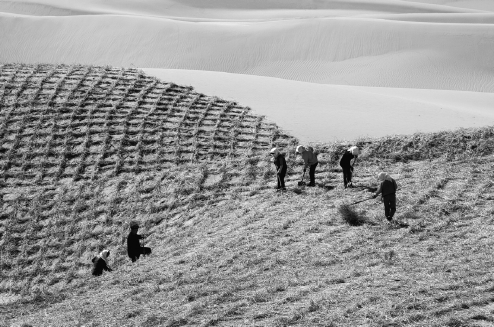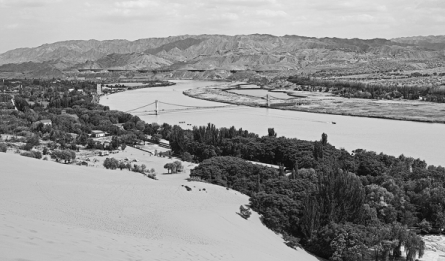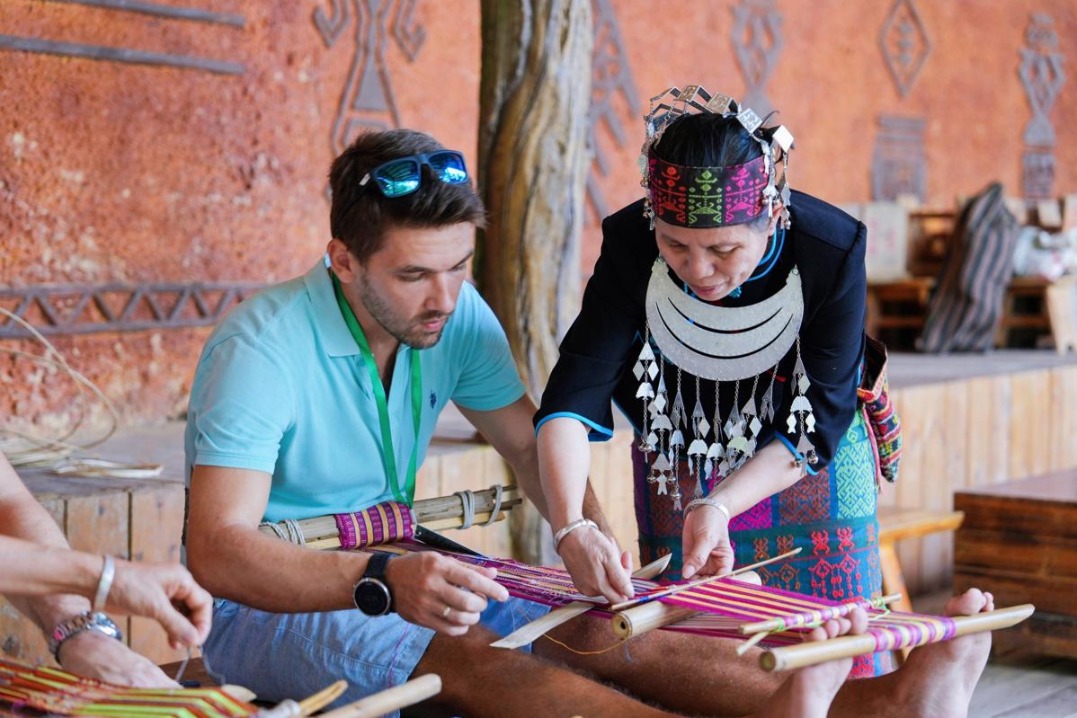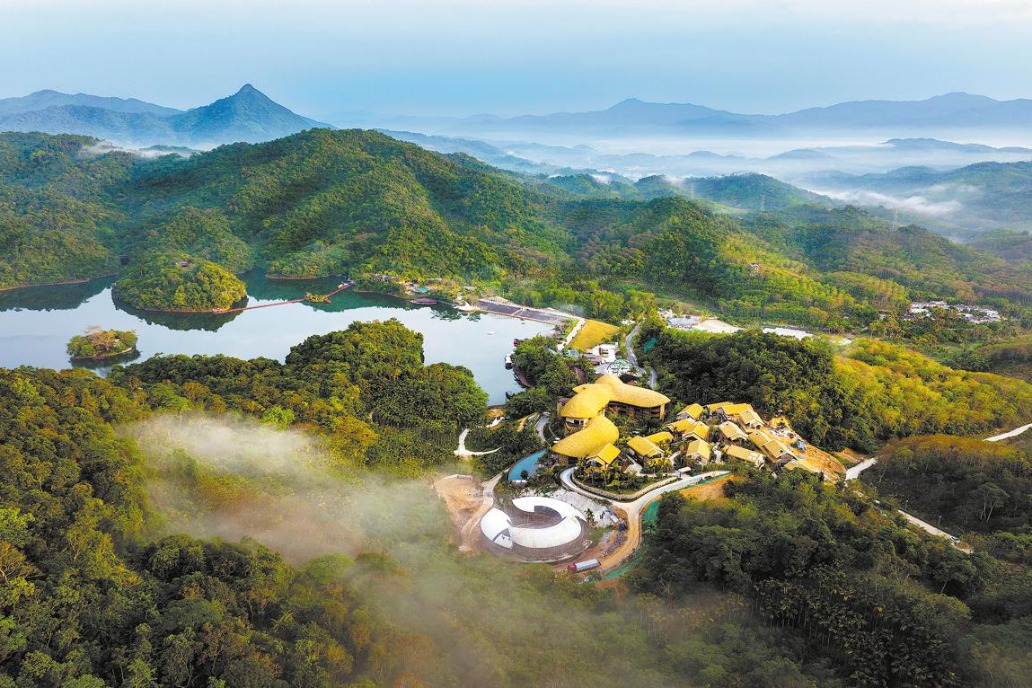A cloud in the desert
Zhongwei is a city embracing new tech, Liu Weiling and Li Yingxue report.

Like many, the first thing Ji Xuexin does every working day is look at her phone. Not, however, to check the latest updates and notifications on social media. As a sanitation inspector in Zhongwei, Northwest China's Ningxia Hui autonomous region, she will open the sanitation cloud app to check the status of the sanitation workers in her jurisdiction and upload the most recent sanitation data.
Since 2016, Zhongwei has been running an intelligent sanitation cloud management system that combines technologies including geographic information systems, the Internet of Things and mobile internet.
The city has set a standard that, on its streets, fly ash per square meter should be less than 5 grams and that rubbish and litter should be removed within five minutes. The sanitation cloud app is helping to achieve that goal by distributing resources more effectively.
Located to the south of China's fourth-largest desert, the Tengger, Zhongwei strives to develop its cloud computing industry together with desertification control and has seen initial success.
According to Li Bin, deputy director of Zhongwei cloud computing and big data development bureau, the development of the cloud computing industry in Zhongwei started in 2013 and it has been taking active measures to build its Western Cloud Base into one of the country's major agglomeration areas for a data center.
"We have attracted over 140 companies from home and abroad to settle in our cloud base, including Amazon Web Services, Qihoo 360, Meituan and Meili Cloud," Li says. "In the first three quarters, we have accomplished fixed asset investment of 780 billion yuan ($117.8 million) and the accumulated fixed asset investment has reached 7.42 billion yuan."
Li recalls that when AWS were looking for a location to build its data center in China, they visited 83 cities and listed 282 conditions. "In the end, they concluded that Zhongwei is the best location."
Li thinks there are several advantages that Zhongwei has when looking to develop a cloud base. "First, Zhongwei is within 2,000 kilometers of most of the major cities in China, which is an optimal distance for building a fiber-optic network," he says.
Second, the geological structure of the region is stable, so that it's incredibly rare for there to be an earthquake exceeding a magnitude of 7.0. The abundant land resources and the climate are also advantages-the annual average temperature is 8.8 C and there are over 280 days in a year that the atmospheric environment is excellent.
"Last but not least, clean energy creates over half the generated electricity in Zhongwei and the price of water and natural gas is low," Li says.
The electricity price is at 0.36 yuan per kilowatt-hour, which is quite low in China.
"The weather here can help the cloud base utilize technology that enables the wind to cool the servers, which makes the power usage effectiveness 1.1-much lower than the national average of around 1.8," he says.
In the first three quarters in 2020,100,000 more servers have been added to the cloud base in Zhongwei and there are almost half a million servers in total.
"In the first three quarters, the total output value of information transmission and information technology service industries has occupied one third of the gross domestic product in Zhongwei," Li says.
Local companies have also been eliminating industries that involve high energy consumption and high pollution and embracing cloud technology.
The Meili Cloud Computing Industry Investment Co has transferred its focus from a papermaking company which was once the only listed company in Zhongwei. It's now building a data center and photovoltaic power station.
For local people, cloud technology has changed from a strange concept to something that they all relate to-the city has developed many cloud services including government administration, sanitation, education and tourism, bringing more convenience to their daily lives.
According to Zhu Wenjun, deputy general manager of Zhongwei Shapotou scenic spot, cloud technology has been used to better serve tourists.
"For example, before utilizing the new technology, a ticket could only be used once. Now, with facial recognition technology and data storage, tourists can enter our scenic area the following day," Zhu says.
He adds that the data can also analyze the tourists' background information, which helps them to design future tourism products and advertisement targeting.
Chinese magic cube
In the 1950s, the western side and northern half of Zhongwei was covered by the Tengger Desert, which once reached just 6 kilometers away from its urban areas-even a gentle breeze would blow dust and sand into homes.
In 1955, construction started on the Baotou-Lanzhou Railway-in Zhongwei, the railway needed to cross the Tengger Desert six times, especially in Shapotou area, as the shifting sand was a big threat to the tracks.
According to Zhang Kezhi, 74, the former head of Zhongwei sand stabilization tree farm, experts from the former Soviet Union predicted that within 30 years, the railway would be buried by sand, and the reason was obvious: the vegetation coverage around the railway was less than 5 percent and the dry sand layer could be as thick as 10 to 15 centimeters.
Initially, Zhang and his team's main task was to clean the sand away from the railway as soon as it was found to be covered over. In 1968, the team changed their task-they used wheat straw to pave 1-meter-long checkerboard sand barriers onto the sand to stabilize it, before sowing grass seeds and planting shrubs.
"If you place the square too small, the sand will bury the straw square; and if it is too loose, it won't stabilize the sand and will be easily broken by the wind. The 1 x 1 meter square proved to be the most suitable for halting the movement of the shifting sand dunes," Zhang says.
The straw is put on top of the sand before being partially buried into the sand by shoveling so that around 15 centimeters is above the sand and 10 centimeters is below the surface.
Tang Ximing, deputy head of Zhongwei sand stabilization tree farm, invented a tool to place plants deep into the sand, which has since been used by many other provinces and saved funds of over 60 million yuan.
Since 1992, the straw squares have not only protected the railway but also stopped the sand from flowing into the city.
Zhongwei sand stabilization tree farm was enlisted in the Global 500 Roll of Honor for Environmental Achievement established by United Nations Environment Programme in 1994.
The straw square method to stabilize sand is called the Chinese magic cube, and it has attracted experts and officials from over 60 countries to come and learn about it.
Zhongwei has finished building the straw square and growing shrub wood, which now covers 28,000 hectares, and has built a 60-kilometer long tree belt for wind management and sand stabilization.
The distance between the desert and Zhongwei has now been pushed back to over 20 kilometers.
Hu Dongmei contributed to this story.



Today's Top News
- China-US officials hold economic talks
- Ensuring safety and transparency in 'pre-made' food
- Forum seeks fairer, more rational global order
- China, Canada vow to steer ties on track of development
- Hit TV series sparks wave of remembrance, patriotism
- Cities get new lease on life






























